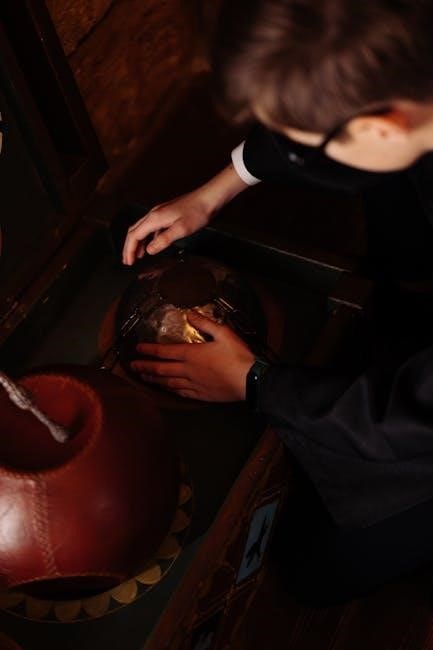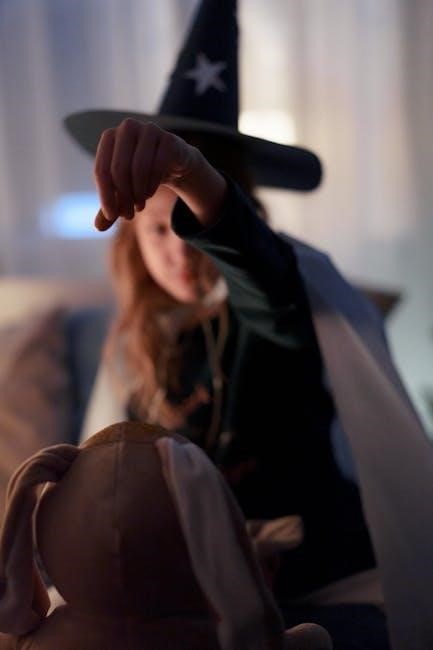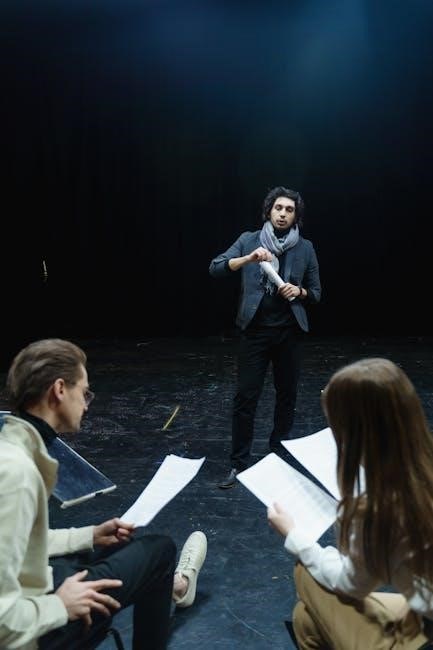
wizard of oz script play pdf
Article Plan: Wizard of Oz Script Play PDF
This article will explore resources for obtaining “The Wizard of Oz” play script in PDF format․ We will examine official publishing houses and online script repositories, while also discussing the elements, adaptations, legal considerations, and educational use of the script․ Character analysis and script comparisons will be included․
“The Wizard of Oz,” a timeless classic, has captivated audiences for generations through its various adaptations, notably including stage plays․ These play scripts, often available in PDF format, offer a unique opportunity to bring the magical land of Oz to life in schools, community theaters, and other performance settings․ The scripts stay true to L․ Frank Baum’s beloved story, allowing performers and audiences to immerse themselves in Dorothy’s journey down the Yellow Brick Road․
Play scripts typically encompass the entire narrative, including dialogue, stage directions, and character descriptions, acting as a blueprint for theatrical productions․ With readily accessible scripts, directors can easily adapt the story for varying cast sizes and skill levels․ These scripts often provide creative insights into the original novel and film, while allowing for personal interpretation․ The scripts can be both faithful renditions and imaginative reinterpretations․
The availability of “Wizard of Oz” play scripts in PDF format has further democratized access to this classic tale, making it easier than ever for individuals and organizations to stage their own productions and share the magic of Oz with new audiences․

Availability of “Wizard of Oz” Play Scripts in PDF Format
The digital age has significantly altered how we access and consume media, and play scripts are no exception․ “The Wizard of Oz” play script, a staple for theatrical productions, is now widely available in PDF format, offering convenience and accessibility to directors, actors, and educators alike․ This digital format allows for easy distribution, printing, and annotation, streamlining the production process․
The widespread availability of “Wizard of Oz” play scripts in PDF format stems from several sources․ Many official publishing houses that license performance rights also offer digital versions of their scripts․ These PDFs are often accompanied by additional resources, such as character breakdowns, costume suggestions, and set design ideas․
Furthermore, numerous online script repositories and educational websites provide access to “Wizard of Oz” scripts in PDF form, sometimes free of charge or for a nominal fee․ These online resources can be a valuable starting point for those seeking to stage a production, offering a range of adaptations and versions to suit different needs and budgets․ However, it’s crucial to be aware of copyright restrictions and licensing requirements when using these scripts․

Sources for Finding “Wizard of Oz” Script PDFs
Finding “Wizard of Oz” script PDFs involves exploring official publishing houses, which often offer licensed versions․ Online script repositories also provide options, though copyright should be carefully considered․ Educational websites may offer abridged versions too․
Official Publishing Houses
When seeking a legitimate “Wizard of Oz” play script in PDF format, official publishing houses are the most reliable source․ These publishers typically hold the rights to the play and offer scripts that are legally compliant for performance and educational purposes․ Eldridge Publishing is one such entity, offering a complete script of “The Wizard of Oz” suitable for various productions․
These official sources ensure that the script adheres to the original work by L․ Frank Baum and any adaptations authorized by the copyright holders․ Purchasing or licensing scripts from these publishers supports the playwrights and ensures that you are using a version that is both accurate and legal․
Furthermore, official publishing houses often provide additional resources such as character breakdowns, stage direction notes, and musical scores (if applicable), which can be invaluable for directors and actors․ Always verify the authenticity and licensing terms before acquiring any script from any source․
Online Script Repositories
Beyond official publishing houses, various online script repositories offer “Wizard of Oz” play scripts in PDF format․ These platforms can be a convenient way to access scripts, but it’s crucial to exercise caution and verify the legitimacy of the source․ Some repositories may host unauthorized or altered versions of the script, potentially leading to copyright infringement issues․
Websites dedicated to amateur theater or educational resources often provide scripts for “The Wizard of Oz,” but their compliance with copyright laws should be carefully checked․ Look for indications of permission from the rights holders or disclaimers regarding usage rights․ Free download sites should be approached with skepticism, as they may distribute illegal copies․
Reputable online script repositories might offer abridged or adapted versions of the play, which can be suitable for schools or community theaters with limited resources or specific performance needs․ Always review the script thoroughly to ensure it meets your requirements and adheres to legal standards․

Elements Included in a “Wizard of Oz” Play Script
A complete “Wizard of Oz” play script contains several essential elements that bring the story to life on stage․ These elements provide the framework for actors, directors, and designers to create a captivating theatrical experience․ The script typically includes a detailed character list, outlining the roles of Dorothy, Scarecrow, Tin Man, Lion, Wicked Witch, Glinda, and other memorable figures․
Dialogue forms the core of the script, presenting the conversations between characters and driving the narrative forward․ Stage directions are crucial, indicating character movements, expressions, and interactions with the set․ Scene descriptions paint a vivid picture of the setting, including locations like Kansas, Munchkinland, the Emerald City, and the Witch’s castle․
Musical cues are often included, particularly in adaptations that incorporate songs from the original film․ These cues specify when and how musical numbers should be integrated into the performance․ Finally, the script may contain notes on costumes, props, and special effects, guiding the production team in creating a visually stunning and faithful rendition of the beloved story․

Adaptations and Abridged Versions
“The Wizard of Oz” has seen countless adaptations and abridged versions over the years, catering to diverse audiences and performance settings․ These adaptations range from full-length theatrical productions to shorter, simplified versions designed for school plays or community theater groups․ Abridged versions often streamline the plot, reduce the number of characters, and simplify the dialogue to make the play more accessible to younger actors or audiences with shorter attention spans․
Adaptations may also incorporate new musical numbers, updated dialogue, or reinterpretations of the original story’s themes․ Some adaptations may focus on specific aspects of the story, such as the journey of self-discovery or the importance of friendship․ Others may explore the darker elements of the narrative, such as the Wicked Witch’s motivations or the deceptive nature of the Wizard himself․
Ultimately, the choice of adaptation depends on the specific goals and resources of the production team․ Whether it’s a faithful recreation of the classic film or a bold new interpretation, “The Wizard of Oz” continues to inspire creativity and innovation in the world of theater․

Legal Considerations When Using “Wizard of Oz” Scripts
When considering a production of “The Wizard of Oz,” it’s crucial to address the legal considerations surrounding the use of copyrighted materials․ “The Wizard of Oz” is protected by copyright law, meaning that performing the play, even in an abridged or adapted form, typically requires obtaining the necessary rights and permissions from the copyright holder․
Unauthorized performances can lead to legal repercussions, including fines and injunctions․ To avoid these issues, it’s essential to identify the copyright holder for the specific script you intend to use․ This information can often be found on the script itself or through performing rights organizations․
Once the copyright holder is identified, you’ll need to apply for a license to perform the play․ The licensing agreement will outline the terms and conditions of the performance, including the royalties that must be paid to the copyright holder․ The cost of the license can vary depending on factors such as the size of the audience, the number of performances, and the type of organization producing the play․
Navigating copyright law can be complex, so it’s always a good idea to consult with an attorney or a licensing expert to ensure that you’re in compliance with all applicable regulations․

Educational Use of “Wizard of Oz” Play Scripts
“The Wizard of Oz” play script offers a wealth of educational opportunities across various age groups and subject areas․ Its engaging storyline, memorable characters, and timeless themes make it an ideal tool for fostering creativity, critical thinking, and collaborative learning in the classroom․
Younger students can benefit from acting out scenes from the play, which helps develop their reading comprehension, vocabulary, and public speaking skills․ The play also provides a platform for exploring themes of friendship, courage, and self-discovery, promoting social and emotional learning․
Older students can delve deeper into the literary aspects of the script, analyzing character motivations, plot structure, and thematic elements․ They can also compare and contrast the play script with the original novel and the film adaptation, examining how the story has been interpreted and adapted across different mediums․
Furthermore, “The Wizard of Oz” play script can be used to integrate other subject areas, such as history, music, and art․ Students can research the historical context of the story, learn about the music and songs featured in the play, and create costumes and set designs inspired by the Land of Oz․ The script can be used as an interactive game-quest․

Thematic and Literary Elements in the Script
“The Wizard of Oz” play script is rich in thematic and literary elements, making it a valuable resource for exploring complex ideas and literary techniques․ The play explores universal themes such as the importance of home, the power of friendship, and the journey of self-discovery․ Dorothy’s quest to return to Kansas symbolizes the longing for belonging and the realization that true happiness can be found within oneself․
The script employs various literary devices, including symbolism, allegory, and metaphor․ The Yellow Brick Road represents the path to achieving one’s goals, while the Emerald City symbolizes the allure of superficial appearances․ The characters themselves embody different aspects of the human condition: the Scarecrow represents intelligence, the Tin Man represents compassion, and the Cowardly Lion represents courage; The play also incorporates elements of fantasy and adventure, creating a magical world filled with whimsical creatures and fantastical landscapes․
Furthermore, the script’s use of dialogue, imagery, and stage directions contributes to its overall effectiveness as a dramatic work․ The dialogue is witty and engaging, while the imagery evokes a vivid sense of time and place․ The stage directions provide guidance for actors and directors, helping them bring the story to life on stage․

Character Analysis in the Play Script
The “Wizard of Oz” play script presents a diverse cast of characters, each with distinct personalities, motivations, and arcs․ Dorothy, the protagonist, embodies innocence, courage, and determination․ Her journey is driven by a desire to return home, and along the way, she learns valuable lessons about friendship and self-reliance․ The Scarecrow, initially lacking confidence in his intelligence, discovers his innate wisdom through his experiences․ The Tin Man, yearning for a heart, learns the importance of empathy and compassion․
The Cowardly Lion, despite his fears, demonstrates bravery in the face of danger․ The Wicked Witch of the West serves as the antagonist, representing evil and oppression․ Her desire to possess the ruby slippers drives the conflict in the story․ Glinda, the Good Witch of the North, acts as a mentor and guide to Dorothy, offering wisdom and support․ The Wizard, initially perceived as powerful and all-knowing, is revealed to be an ordinary man who uses illusions to maintain his authority․
Through their interactions and individual journeys, the characters in “The Wizard of Oz” play script explore themes of self-discovery, courage, and the importance of inner qualities․

Comparison of Script Versions to the Original Novel
Comparing “The Wizard of Oz” play script versions to L․ Frank Baum’s original novel, “The Wonderful Wizard of Oz,” reveals both faithful adaptations and creative liberties․ Many scripts retain the core storyline, character arcs, and thematic elements of the novel, including Dorothy’s journey, the companions she meets, and the ultimate discovery that “there’s no place like home․” However, adaptations often streamline the plot, condense dialogue, and add or remove scenes to suit the stage format and cater to different audiences․
Some script versions may emphasize certain characters or subplots, while others may introduce new songs, musical numbers, or comedic elements․ Character portrayals can also vary, with some adaptations focusing more on specific traits or relationships․ Examining these differences provides insight into the creative choices made by playwrights and the ways in which they interpret and reimagine Baum’s classic tale․ Analyzing the script’s adherence to the novel’s spirit, while also acknowledging its unique artistic contributions, allows for a deeper understanding and appreciation of both works․